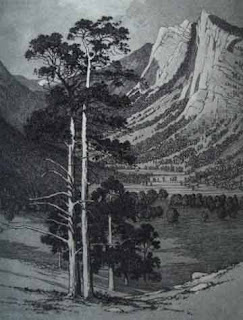Thinking of warmer climates and the beauty of the southwest led me to discover the work of George Elbert Burr (1859–1939). I immediately fell in love with his work and felt transported to Arizona once I saw his images of the Sonoran desert. For anyone enthralled with this part of the world, Burr gets it right when he describes the landscape's great sense of space and open sky. His sensitivity for light is key in these images; which helps one feel the time of day and the season of the year. (Yes, deserts experience seasons, too.)
Burr captures the beauty of this rugged landscape and the plants and trees one can find there, but he also has a command of the area's mountainous terrain and the intimacy and openness we can find walking among the rocks and ravines. I think you will agree with me that Burr's work has an honesty for observation and a respect for Mother Nature. His works come up for auction from time to time, and the prices are reasonable for anyone wanting to add his printed gems to their collection. Enjoy, and see if these images don't draw you to take a trip out west to see them for yourselves.
BIO
George Elbert Burr was an American printmaker known for his images of the American southwest. He is widely regarded as one of the finest of the early 20th-century American printmakers.
Born in Munroe Falls, Ohio, Burr moved with his parents to Cameron, Missouri, where his father ran a hardware store. Burr was interested in art from an early age and his first prints were created with the use of a press located in his father's store.
In 1878, Burr attended the Art Institute of Chicago (then called the Chicago Academy of Design). He studied there briefly, then achieved commercial success as an illustrator, providing illustrations for Harper's, Scribner's Magazine, Frank Leslie's Weekly, and The Cosmopolitan. From 1892-1896, he illustrated a collection of jade antiquities for the Metropolitan Museum of Art. During this project Burr produced etchings of over a thousand artifacts.
After an illness, Burr moved to Denver for his health and it was there that he began Nature studies and the Rocky Mountains. Burr spent his winters traveling through the deserts of Southern California, Arizona, and New Mexico, which prompted him to move permanently to Phoenix. The southwestern landscape and its expansive views of the Sonoran and Mojave deserts were fascinating to him, and he focused entirely on that subject for the rest of his career.
He was a member of New York Society of Etchers and the Brooklyn Society of Etchers, and president of the Phoenix Fine Arts Association. During his career, Burr created over twenty-five thousand etchings, all pulled from his own presses.
Public Collections:
Art Institute of Chicago
Boston Museum of Fine Arts
Brooklyn Museum
Carnegie Institute
Cleveland Museum of Art
Denver Art Museum
Detroit Institute
Fogg Art Museum
Library of Congress
Los Angeles County Museum of Art
Metropolitan Museum of Art
New York Public Library
Smithsonian American Art Museum
Toledo Museum of Art
Bibliothéque Nationale
Victoria and Albert Museum
British Museum








No comments:
Post a Comment